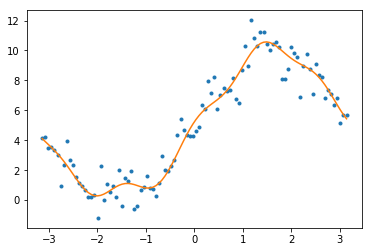Hands-On Machine Learning -- SVM
SVM 线性分类器
本例使用 iris 数据集来做分类。
# 导入模块
import numpy as np
import matplotlib.pyplot as plt
导入数据
from sklearn import datasets
iris = datasets.load_iris()
============== ==== ==== ======= ===== ====================
Min Max Mean SD Class Correlation
============== ==== ==== ======= ===== ====================
sepal length: 4.3 7.9 5.84 0.83 0.7826
sepal width: 2.0 4.4 3.05 0.43 -0.4194
petal length: 1.0 6.9 3.76 1.76 0.9490 (high!)
petal width: 0.1 2.5 1.20 0.76 0.9565 (high!)
============== ==== ==== ======= ===== ====================
上面是数据集的概要,每个样本包含 4 个属性,此处只选择了相关系最高的两个。
X = iris['data'][:, (2, 3)]
y = (iris['target'] == 2).astype(np.float64)
划分训练集和测试集
from sklearn.model_selection import train_test_split
X_train, X_test, y_train, y_test = train_test_split(X, y, test_size=0.3)
训练 SVM 分类器
SVM 分类器对数据尺度非常敏感,因此在数据预处理阶段,要对样本属性值进行标准化操作,可以使用 StandardScaler 轻松完成此操作。
使用 SVM 对线性可分的样本进行分类,可以使用 LinearSVC,也可以使用 SVC(kernel='linear'),但是后者的速度要慢很多。
现实场景下,完全线性可分的数据很少,SVM 的软间隔用来完成近似线性可分的样本集的分类。LinearSVC 中的 C 参数表示惩罚程度,此处即对落入 margin 内样本的惩罚程度。C 越大,当样本落入 margin 中时,损失就越大,因此为了让的样本不落入 margin 中,相应地 margin 也就越窄。
这里 hinge 损失函数是 SVM 默认的损失函数。
from sklearn.svm import LinearSVC
from sklearn.pipeline import Pipeline
from sklearn.preprocessing import StandardScaler
svm_clf = Pipeline((
('scaler', StandardScaler()),
('linear_svc', LinearSVC(C=1, loss="hinge"))
))
svm_clf.fit(X_train, y_train)
评估性能
from sklearn.metrics import precision_score, recall_score
y_pred = svm_clf.predict(X_test)
precision_score(y_test, y_pred), recall_score(y_test, y_pred)
准确率和召回率:
(0.8571428571428571, 0.9230769230769231)
观察决策面(线)
import matplotlib.pyplot as plt
def plot_predictions(clf, axes):
x1 = np.linspace(axes[0], axes[1], 100)
x2 = np.linspace(axes[2], axes[3], 100)
X1, X2 = np.meshgrid(x1, x2)
X = np.vstack((X1.ravel(), X2.ravel())).T
Y = clf.predict(X).reshape(X1.shape)
plt.contourf(X1, X2, Y, cmap=plt.cm.brg, alpha=0.2)
plt.plot(X_test[y_test == 0, 0], X_test[y_test == 0, 1], 'rv')
plt.plot(X_test[y_test == 1, 0], X_test[y_test == 1, 1], 'go')
plot_predictions(svm_clf, [1, 7, 0, 3])

非线性 SVM 分类器
生成数据集
make_moons 用于生成呈半月形分布的两类样本,此处用它来生成样本。
from sklearn.datasets import make_moons
X, y = make_moons(n_samples=200, noise=0.15, random_state=42)
# 观察样本
plt.plot(X[:, 0][y==0], X[:, 1][y==0], 'b.')
plt.plot(X[:, 0][y==1], X[:, 1][y==1], 'g.')

## 划分训练集和测试集
from sklearn.model_selection import train_test_split
X_train, X_test, y_train, y_test = train_test_split(X, y, test_size=0.3)
训练分类器
这个数据集是线性不可分的,但可以样本增加属性,将其升至高维。在高维空间中能够找到一个超平面,将两类样本分开。
此处使用 PolynomialFeatures 来给样本增加属性,新增的属性值是原属性的四阶多项式。
from sklearn.pipeline import Pipeline
from sklearn.preprocessing import PolynomialFeatures
from sklearn.preprocessing import StandardScaler
ploy_svm_clf = Pipeline((
('poly_features', PolynomialFeatures(degree=4)),
('scaler', StandardScaler()),
('svm_clf', LinearSVC(C=1, loss="hinge"))
))
ploy_svm_clf.fit(X_train, y_train)
### 观察决策面(线)
plot_predictions(ploy_svm_clf, [-2, 3, -1, 1.5])
plt.plot(X_train[y_train == 1, 0], X_train[y_train == 1, 1], 'g.', alpha=0.4, label="train 1")
plt.plot(X_train[y_train == 0, 0], X_train[y_train == 0, 1], 'rx', alpha=0.4, label="train 0")
plt.plot(X_test[y_test == 1, 0], X_test[y_test == 1, 1], 'gv', label="test 1")
plt.plot(X_test[y_test == 0, 0], X_test[y_test == 0, 1], 'r^', label="test 0")
plt.legend(loc="upper right")

可以看到测试集被完全正确地分类。
使用多项式核
前面解决线性不可分问题的方法是采用 PolynomialFeatures 给样本增加额外的属性。SVM 分类器可以用核方法来处理线性不可分问题,多项式核将样本属性值做多项式变换,使原来线性不可分样本转变为线性可分。
下面示例这里使用多项式核来进行分类,这里用到了 SVC 类,它有以下重要参数:
kernel='poly'表明使用多项式核degree=3表示最高为 3 阶coef0用于控制分类器对高阶项的偏重,此值越大越偏向于高阶。
#### 训练分类器
from sklearn.svm import SVC
poly_kernel_svm_clf = Pipeline((
('scaler', StandardScaler()),
('svm_clf', SVC(kernel='poly', degree=3, coef0=1, C=5))
))
poly_kernel_svm_clf.fit(X_train, y_train)
用 SVM 做回归
SVM 还可以用来做回归,只需要在分类的思想上稍作变换,即让尽可能多的样本落在 margin 中,同时让 margin 尽可能窄。
生成数据
x = np.linspace(-np.pi, np.pi, 100);
y = 5 * np.sin(x) + 5 + np.random.randn(x.shape[0])
plt.plot(x, y, '.')

使用线性回归
上面生成的数据显然不是线性的,可以通过将样本做多项式变换,就可以使用 LinearSVR 来做线性回归了。
LinearSVR 的 epsilon 参数用于控制 margin 的宽度,这个值越小 margin 也就越小。
from sklearn.svm import LinearSVR
X = x.reshape(x.shape[0], 1)
svm_reg = Pipeline((
('poly', PolynomialFeatures(degree=7)),
('scaler', StandardScaler()),
('svm_clf', LinearSVR(epsilon=1))
))
svm_reg.fit(X, y)
y_pred = svm_reg.predict(X)
plt.plot(x, y, '.')
plt.plot(x, y_pred, '-')

使用多项式核
也可以使用 SVR 利用其自身具备的核函数做非线性变换,来完成对非线性样本的回归。
当样本较大的时候,比如大于 1000 个,如果使用多项式核,SVR 就已经变得很慢了。此处使用默认的 rbf 核,稍快一些。
这里的参数 C 表示对误差的惩罚度,如果此值很小,常常会欠拟合,如果此值太大可能会过拟合。
from sklearn.svm import SVR
X = x.reshape(x.shape[0], 1)
poly_svm_reg = SVR(C=1, epsilon=0.01)
poly_svm_reg.fit(X, y)
y_pred = poly_svm_reg.predict(X)
plt.plot(x, y, '.')
plt.plot(x, y_pred, '-')
